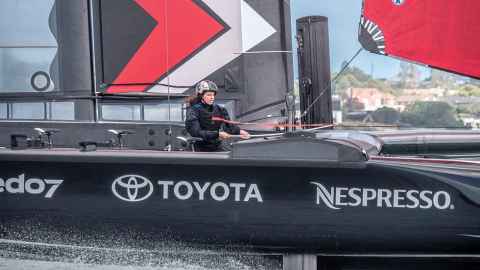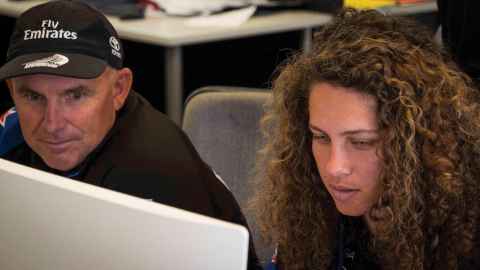Designing the future of sailing
19 October 2018
In a sport where every second is crucial, design innovation can mean the difference between victory and failure.

It was for her contribution in these crucial moments that Engineering alumna Elise Beavis went down in history as one of the designers who helped secure the 35th America’s Cup in 2017. At the time, she was just 22 and an intern for Emirates Team New Zealand.
On her first day, she was asked to help research the viability of the sailors cycling, as opposed to using the traditional grinding method. It became a bigger task than anyone expected, but they pulled it off – and for the first time, the team sailed using pedal power. This, ultimately, was one of the key factors for Emirates Team New Zealand in Bermuda, in taking down the opposition and sailing to success.
Elise also worked on various projects ahead of the 2017 campaign, which included fitting the entire boat, the chase boat and all the required tools and equipment onto the plane. They all sighed a breath of relief on the tarmac when the doors managed to close.
She travelled to Bermuda with the team for the campaign and returned as a hero, which she says was a great surprise.
“A couple of times at the supermarket when I’ve had my Emirates Team New Zealand jacket on, they would go: ‘Oh, you’re that girl!’ But I guess from a design perspective it’s quite nice, because at the end of the day, typically it’s the sailors that are the celebrities.”
Elise became the team’s golden girl and they snapped her up full-time as soon as she graduated from the University of Auckland with a Bachelor of Engineering.

Talking about her passion for sailing and engineering comes naturally to her. It’s a skill she has needed after being swamped by media requests and invitations to speak at various events. She takes it in her stride and is particularly dedicated to showing school students there is a vast range of careers in engineering to pursue.
“My favourite talk I’ve done is the Auckland Girls’ Regatta, which is for girls aged nine to 17, because I could really relate to them. With an older, more technical audience, sure, you get good questions and they understand things, but you don’t feel like you are really making a difference to their lives.
“If I was one of those girls and an older version of me had come along and said ‘these are the career opportunities in the sailing industry’ and had been able to talk about working at Emirates Team New Zealand, that would have been hugely valuable for me.”
She says it often feels like all fun and games, but sailing is something the nation cares deeply about, which she discovered when the team returned home with the Auld Mug.
“In Bermuda we were so isolated from what was going on, we sort of didn’t realise what it meant to people. It wasn’t until we came back and did the parades, and you had all these people out in the pouring rain or freezing cold, [that we realised] people actually care and it has an impact on their life.”
Her time at the University of Auckland was invaluable, and she uses the skills she learnt on a daily basis. She says it is a great place to study, particularly for young women.
“If you’re going to go to any university in the world to study engineering, and you want to be around girls, Auckland is the place to go, they’re very supportive.”
It’s all hands on deck as the team gears up for the 2021 campaign. Elise loves that she has been involved from the beginning this time around, where every day the aim is to make the boat go faster.
“Being involved from day one is cool, because you get the whole story, from the progression of the type of boat, concepts, and left-field ideas. This time I’m seeing more of the bigger picture and having increasing responsibility in my work.”
By Briar Hubbard
Ingenio: Spring 2018
This article appears in the Spring 2018 edition of Ingenio, the print magazine for alumni and friends of the University of Auckland.